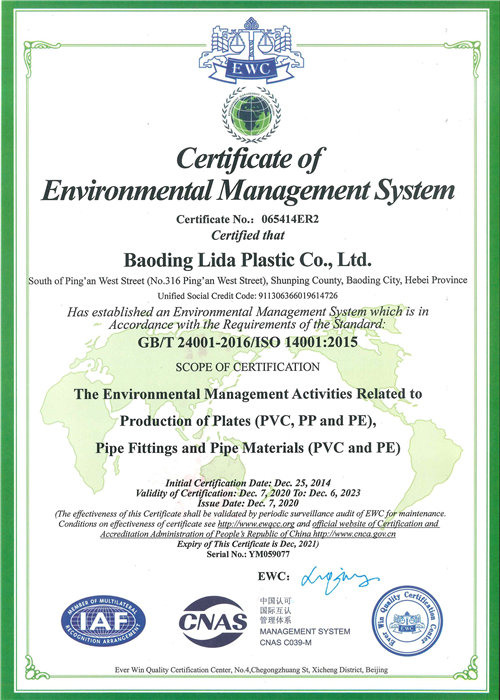Nov . 26, 2024 21:27 Back to list
Understanding the Benefits and Applications of PVC-O Pipe in Modern Infrastructure
Understanding PVC-O Pipes Features and Advantages
Polyvinyl Chloride (PVC) has been a staple in the construction and plumbing industries for decades, known for its versatility, durability, and cost-effectiveness. Among the various types of PVC pipes available, PVC-O (or oriented PVC) pipes have gained significant attention in recent years. This article aims to delve into the features, manufacturing process, advantages, and applications of PVC-O pipes, shedding light on why they are becoming a preferred choice for many infrastructure projects.
What is PVC-O?
PVC-O pipes are a variation of traditional PVC pipes, designed for enhanced performance. The O in PVC-O stands for oriented, which refers to the molecular orientation during the manufacturing process. This orientation significantly improves the physical and mechanical properties of the pipes, making them stronger, more flexible, and more resistant to stress compared to standard PVC pipes.
The Manufacturing Process
The production of PVC-O pipes involves a unique process known as orientation. It begins with the extrusion of conventional PVC pipes, which are then subjected to a stretching process. This involves elongating the pipe under controlled conditions, which aligns the PVC molecules in a way that enhances the material's overall strength and elasticity. The result is a pipe that not only exhibits improved mechanical properties but also retains the advantageous characteristics of traditional PVC.
Key Features of PVC-O Pipes
1. High Strength-to-Weight Ratio One of the most notable features of PVC-O pipes is their exceptional strength-to-weight ratio. They are considerably lighter than many other options, such as ductile iron or steel pipes, making them easier to handle and install.
2. Flexibility The molecular orientation grants PVC-O pipes greater flexibility. This feature is particularly beneficial when dealing with uneven ground conditions or when requiring the pipes to accommodate movement, such as in seismic zones.
3. Corrosion Resistance PVC-O pipes are inherently resistant to corrosion and chemical reaction, a trait that extends their lifespan and reduces maintenance costs over time. This characteristic makes them ideal for various applications, including potable water and wastewater systems.
pvc-o pipe

4. Improved Hydraulic Performance Due to their smooth internal surface, PVC-O pipes allow for reduced friction losses, leading to better flow characteristics. This ensures that less energy is required for pumping and helps improve overall system efficiency.
5. Environmental Benefits The production of PVC-O pipes is less energy-intensive compared to other materials, contributing to a lower carbon footprint. Additionally, they are made from recyclable materials, enhancing their sustainability.
Applications of PVC-O Pipes
PVC-O pipes find a wide array of applications across various sectors. They are commonly used in
- Water Distribution Systems Their durability and strength make them suitable for transporting potable water, ensuring that water quality remains uncompromised.
- Sewage and Drainage The corrosion-resistant properties of PVC-O pipes make them ideal for sewer systems, where exposure to chemicals and other aggressive substances is common.
- Irrigation PVC-O pipes are also well-suited for agricultural applications, providing efficient water delivery systems to enhance irrigation and crop productivity.
- Industrial Applications Industries requiring reliable and strong piping systems benefit from PVC-O's durability, including chemical processing and manufacturing.
Conclusion
As the demand for high-performance piping solutions continues to grow, PVC-O pipes stand out as an innovative choice that combines strength, flexibility, and resistance to environmental factors. Whether in municipal waterworks, industrial applications, or agricultural settings, PVC-O's benefits make it a material that should be considered in modern infrastructure projects. With ongoing improvements in manufacturing technology and increased awareness of sustainability, the future looks bright for PVC-O pipes in the piping industry. As professionals and end-users alike recognize these advantages, PVC-O pipes are likely to continue gaining traction as a go-to solution for reliable and efficient piping systems.
-
Transparent PVC Pipe: Clear Flexible Tubing for Fluids
NewsAug.09,2025
-
Durable PP Rigid Sheet: Versatile & High-Quality Plastic Panels
NewsAug.08,2025
-
Premium Glossy PP Rigid Sheet – Durable & Versatile
NewsAug.07,2025
-
High-Quality HDPE Sheet | Durable Plastic Panels
NewsAug.06,2025
-
High-Precision PVC Rigid Sheets for Vacuum Forming | AI-Optimized
NewsAug.05,2025
-
Durable PVC-M Water Supply Pipes | 60-Year Life
NewsAug.04,2025

